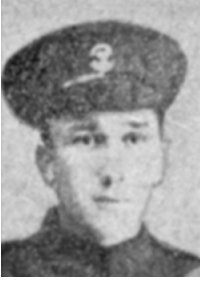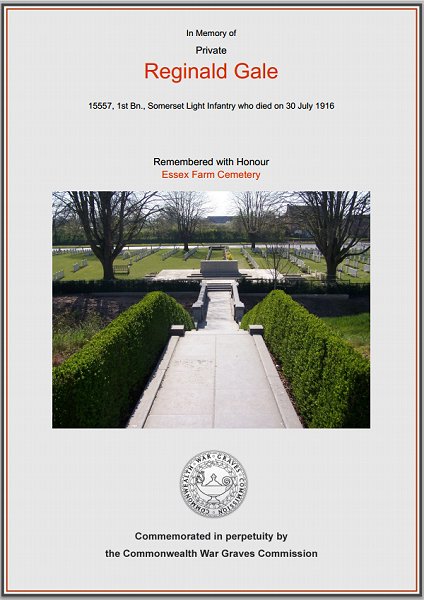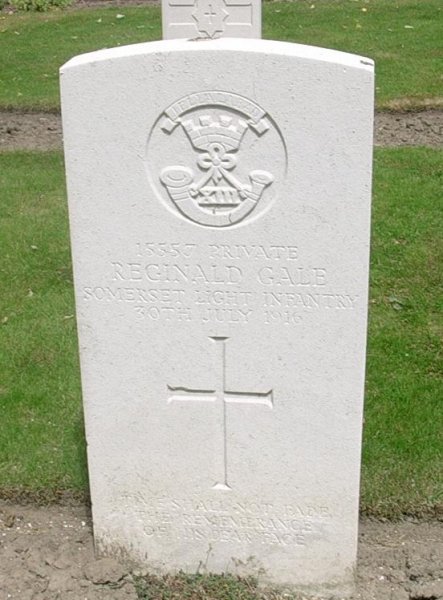yeovil at War
reginald gale
Died in France just days before the Armistice
 Reginald Gale
was born in
Yeovil in 1897,
the son of
joiner/carpenter
Frederick
Herbert Gale
(1863-1934),
originally from
Bridport,
Dorset, and
Maria Ann née
Hawkins (b 1866)
of Yeovil.
Reginald Gale
was born in
Yeovil in 1897,
the son of
joiner/carpenter
Frederick
Herbert Gale
(1863-1934),
originally from
Bridport,
Dorset, and
Maria Ann née
Hawkins (b 1866)
of Yeovil.
In the 1901 census Maria, listed as a leather glover, was living in newly built 1 The Avenue, (no sign of Frederick at this time) with her children; Bessie born 1890, Alice born 1893, Ernest born 1895, Reginald born 1897, Leslie born 1899 and four-month-old Ivy.
By the time of the 1911 census Frederick and Maria were living at 47a Queen Street. They now had a new son Clifford aged eight. Reginald, by now aged 14, gave his occupation as 'Wash House Lad' and was, presumably, working at the Corporation Baths in Huish, just around the corner from his home.
 17-year
old Reginald
enlisted in the
Regular Army in
September 1914
as Private Gale
(Service No
15557) in the
1st Battalion,
Somerset Light
Infantry.
17-year
old Reginald
enlisted in the
Regular Army in
September 1914
as Private Gale
(Service No
15557) in the
1st Battalion,
Somerset Light
Infantry.
At the outbreak of war in 1914 the 1st Battalion was in Colchester, with 11th Brigade, 4th Division. The Battalion landed at Le Havre, France with the British Expeditionary Force (BEF) on 22 August 1914, in time to fight in the battle of Le Cateau during the retreat from Mons. The 1st Battalion, Somerset Light Infantry remained on the Western Front with 4th Division, throughout the war.
After his basic training Reginald would have joined his Battalion at the Front, probably towards the end of 1914.
In 1915 the 1st Battalion, Somerset Light Infantry fought in the Second Battle of Ypres.
The Second Battle of Ypres, 22 April-25 May 1915, was a rare German offensive on the Western Front during 1915. It was launched with two aims in mind. The first was to distract attention from the movement of German troops to the eastern front in preparation for the campaign that would lead to the victory of Gorlice-Tarnow. The second was to assess the impact of poisoned gas on the western front. Gas had already been used on the eastern front, at Bolimov (3 January 1915), but the tear gas used there had frozen in the extreme cold. At Ypres the Germans used the first lethal gas of the war, chlorine. The gas was to be released from 6,000 cylinders and would rely on the wind to blow it over the allied trenches. This method of delivery controlled the timing of the attack – the prevailing winds on the western front came from the west, so the Germans had to wait for a suitable wind from the east to launch their attack. The line around Ypres was held by French, Canadian and British troops. The attack on 22 April hit the French lines worst and, not surprisingly, the line broke under the impact of this deadly new weapon. The gas created a gap 8,000 yards long in the Allied lines north of Ypres. The success of their gas had surprised the Germans who didn’t have the reserves to quickly exploit the unexpected breakthrough, allowing enough time to plug the gap with newly arrived Canadian troops. During the battle the British, French and Canadians suffered 60,000 casualties, the Germans only 35,000.
In 1916 the 1st Battalion moved south and were in action during the Battles of the Somme.
The Battle for the Somme has a unique place in British military history. Haig was in the middle of preparations for a British offensive but came under strong pressure to mount an attack due the French commitment to the Battle for Verdun, a city which held an important place in the nation's psyche and that the Germans had attacked in February 1916. Any Allied offensive would therefore have to be carried mainly by the British. Haig was therefore forced to undertake an offensive near to where the British and French lines met, near Bray-sur-Somme in Picardy, although he would have preferred to attack further north and to have had longer with which to prepare his new army. The battlefield was bisected by both the Albert – Bapaume Road and the River Somme, and was a series of gentle chalk ridge lines into which the Germans had dug a series of well-prepared fortifications. Haig's plan called for Rawlinson’s Fourth Army to achieve a breakthrough in the centre after which Gough’s Reserve Army (later renamed the Fifth Army) would exploit, roll up the German defences and capture Bapaume. Allenby's Third Army would undertake a diversionary attack on Gommecourt, which lay to the north. The massive preparatory bombardment, meant to destroy the German defences started on 24 June 1916 at 06.00. Over 1.7 million shells were fired but a high proportion, some 30 percent, failed to explode as the Ministry of Munitions had abandoned any semblance of quality control in order to be able to produce the quantities needed in time. Tunnelling companies dug hollowed out chambers underneath key German strongpoints and filled them with explosives. The shelling had started on 'U' Day and was meant to go on until 'Z' Day, which was 29 June 1916 but heavy rains caused the approach roads, trenches and crater ridden No-Man's land too muddy and so the assault was postponed until 1 July. Just after dawn on 1 July, the first British wave clambered out of their trenches and started to make their way towards the German frontline. As they did, seventeen enormous mines were detonated and the barrage moved forward. The infantry followed behind and although there were local gains on the first day, generally things looked bleak. The British suffered 57,470 casualties (19,240 killed and 2,152 missing) which was an unprecedented experience for the British Army. Seven 'New Army' divisions attacked, alongside three Territorial and four regular Army divisions. The French attack on the right of the British line was smaller than had been originally intended as troops had to be diverted to the fighting around Verdun but their attack went relatively successfully and the preponderance of heavy guns in the French sector also helped the British forces adjacent to them.
Reginald Gale was reportedly shot and killed by a sniper on 30 July 1916, not in a set battle but in the day-to-day horrors of trench warfare. However he may not have been killed immediately as reported, since he was buried in a cemetery associated with a Dressing Station, intimating that he died from his wound.
The British Army suffered, over the course of the entire 142-day campaign, some 415,000 casualties. The Somme campaign involved some twelve separate battles and finally came to an end on 18 November 1916.
The Western Gazette, on 25 August 1916 reported "News has recently been received of the death in action of 15557 Private Reginald Gale of the Somerset Light Infantry, second son of M. and Mrs E Gale, of 5 Penn Field. Accompanying the notification was a Royal message of sympathy signed by Mr Asquith. Priv. Gale, who was only 19 years of age, joined up in the early part of September 1914, being at that time in his 17th year. In a letter from his corporal it stated that Private Gale was killed by a sniper on the morning of 30th July. The corporal also wrote:- “I hardly know how to express the sorrow of the comrades of his platoon and myself when we heard of his death, especially as we were very great chums.” – Mr and Mrs Gale have also another son serving with a Territorial battalion of the Somersets in India. Mrs Gale has received a letter from Lieut. Howard CJ Mitchelmore, of the Royal Flying Corps:- “Please accept my very deep sympathy at the loss you have sustained in the death of your son; a loss that can only be tempered by the knowledge that he died fighting for the folks at home. For six months I was in charge of the platoon to which he belonged, and of a wonderful cheery crowd he was the most cheery. No matter how much work was to be done, or whatever the weather was, he seemed always to be happy. He has done his bit, the most that any man can do, he gave his life for his country.”
Reginald Gale was interred in Essex Farm Cemetery, Leper, West-Vlaanderen, Belgium, Grave III.A.7, and his name is recorded on the War Memorial in the Borough.
gallery

The Commonwealth War Graves Commission certificate in memory of Reginald Gale.

Reginald Gale's headstone.